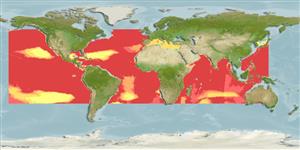Common names from other countries
Classification / Names / Names
Common names | Synonyms | Catalog of Fishes (gen., sp.) | ITIS | CoL | WoRMS
Environment: milieu / climate zone / depth range / distribution range
Ecology
Pelagic-oceanic; depth range 385 - 395 m (Ref. 97142). Tropical; 55°N - 34°S, 170°W - 142°E (Ref. 275)
Circumglobal, mainly found in tropical and subtropical waters but is also found in boreal and notalian waters (Ref. 7575).
Length at first maturity / Size / Weight / Age
Maturity: Lm ? range ? - ? cm Max length : 170 cm ML male/unsexed; (Ref. 97142); max. published weight: 64.4 kg (Ref. 97142)
Life cycle and mating behavior
Maturity | Reproduction | Spawning | Eggs | Fecundity | Larvae
Members of the class Cephalopoda are gonochoric. Male and female adults usually die shortly after spawning and brooding, respectively. Mating behavior: Males perform various displays to attract potential females for copulation. During copulation, male grasp the female and inserts the hectocotylus into the female's mantle cavity where fertilization usually occurs. Life cycle: Embryos hatch into planktonic stage and live for some time before they grow larger and take up a benthic existence as adults.
Roper, C.F.E., M.J. Sweeney and C.E. Nauen. 1984. (Ref. 275)
IUCN Red List Status (Ref. 130435: Version 2024-1)
CITES status (Ref. 108899)
Not Evaluated
Not Evaluated
Human uses
Fisheries: of potential interest
| FishSource |
Tools
More information
Age/SizeGrowthLength-weightLength-lengthMorphologyLarvaeAbundance
Internet sources
Estimates based on models
Preferred temperature
(Ref.
115969): 8.2 - 13.7, mean 10 (based on 18 cells).
Vulnerability
Very high vulnerability (90 of 100).
